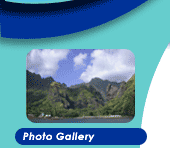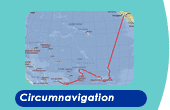Culinary Cruising: Sailing the Turkish Southwestern Coast
By Lois Joy
May 8, 2008
Bayr Ciftlik, Turkey
36º43’ N, 28º14.28 E
At 1030, I selected the Windjammer’s Amazing Grace album on the iPOD, and it rang through the speakers as we departed Marmaris Marina. After a month there, most of it spent working hard to prepare Pacific Bliss for the season, I was ready to leave. But the sad part—as always—was the good-bys, leaving some wonderful friends, both new and old, behind.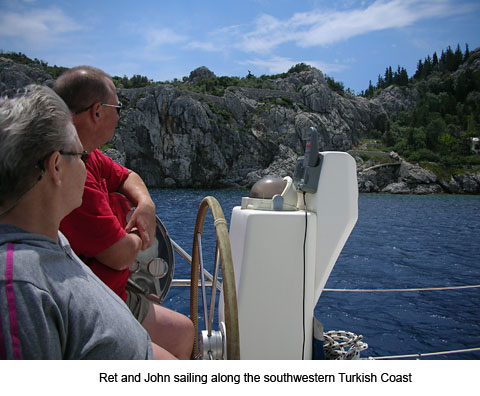
“To the beginning of Voyage Seven, our final voyage,” Gunter and I high-fived my sister Ret and her husband John. This would be their third time with us, having joined us in Queensland, Australia and Phuket, Thailand.
We had not been sailing since June of 2007, our longest stretch on land since we began our circumnavigation in 2000. Captain Gunter and I were definitely rusty. Water gushed into Gunter’s face like a fountain as he worked—head down—in the starboard bilge to make the errant knot meter turn. I forgot to activate the “track” on the MaxSea software, and then wondered why the red circles were not turning a faint orange as we passed each waypoint. Fortunately, our first sail was only a wimpy 15 nautical miles to our first destination, Ciftlik, still in Marmaris Bay. It was too short (only 2.5 hours) to bother with the main, but we did manage to unfurl the jib.
Now we are docked at the Rafet Baba restaurant’s pier. Gunter has fallen in love with this new form of cruising wherein one determines the destination of the day by the menus currently offered in the various restaurants along the way. One merely accesses the information in an advertising brochure called Bay Express—Turkish Coast, with text in Turkish, English and German. The version we are following covers Fethiye to Bodrum. To give you an example, this first stop, called Ciftlik Limani, has a wide-angle photo of the bay with three docks, then an inset and description of each of the three restaurants. Gunter calls this “Culinary Cruising.” I call it “Sailing for Wimps.”
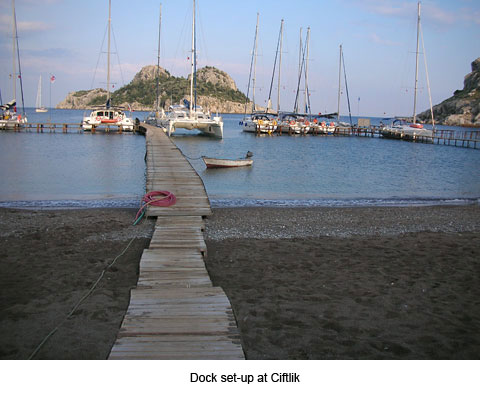
On the other hand, being safely side-tied to the dock, enjoying a feta cheese salad with fresh tomatoes and cucumbers for lunch in the cockpit, watching the threatening thunderclouds loom overhead, this isn’t such a bad idea!
For dinner on shore, we order lamb, chicken, and seafood casseroles and a bottle of Turkish dry red. These are not the casseroles your mother used to bake, complete with cream of mushroom soup. No, served in sizzling, individual ceramic dishes, these casseroles are examples of the “slow food” along this coast. You eat the products right where they are collected, caught, or slaughtered. In these bays, the vegetables grow behind the restaurants, the lamb comes from the hills, and the fish comes from the sea. You start with one of the 80 kinds of Turkish breads, some sauces to dip it in, and sit a very long time to enjoy your meal. I could get used to this.
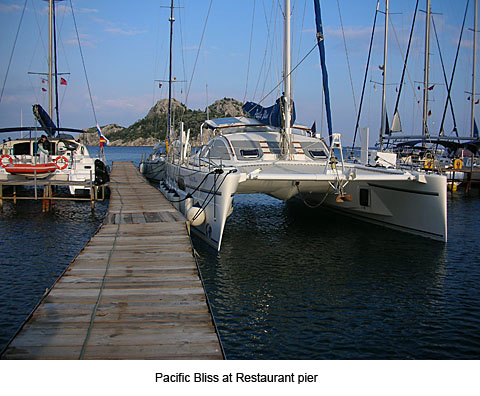
May 9, 2009
Loryma Restaurant Dock, Buku, Turkey
36º34.56’ N, 28ºE
The night was cool at Bayr Ciftlik. My sister Ret and I come up dressed in the matching teal “Teletubby” fleeces that she brought. In the morning we sat writing in our journals while the guys readied Pacific Bliss for departure. We enjoyed a wonderful breakfast of freshly-picked strawberries purchased from the restaurant for 4 lira per kilo, along with strawberry yogurt, and cereal. We conjectured about what other culinary delights might be in store.
Wrap photo 04 of Sisters in fleeces.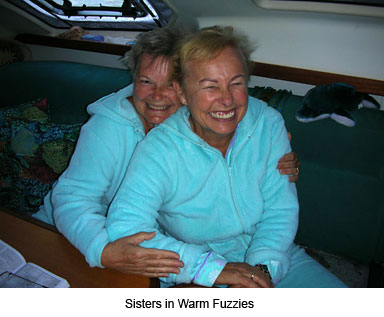
We had a fine sail during our four-hour passage to this restaurant dock. It was an opportunity to use the main and the jib, hard on the wind, sailing at 8.2 knots under a 14-knot northwest wind, called a meltemi.
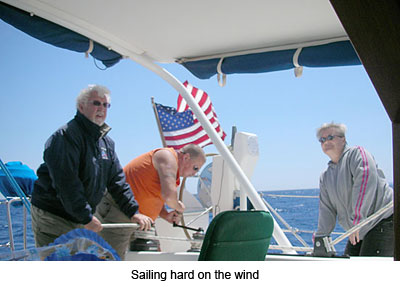
Now med-moored here, we can view the ruins of the old castle at the entrance to the bay and see more remnants of by-gone civilizations where-ever we look. We have a salad on board, followed by well-deserved “pensioner’s naps.” Then we walk down a rickety pier to explore the pastures behind the restaurant, meeting the stares of cattle and averting the cow pies among the rocky landscape. 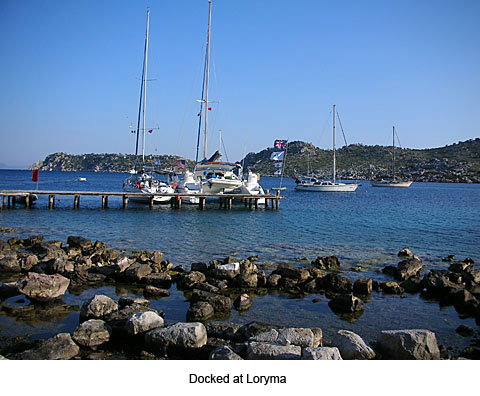
At the restaurant, we spend three hours chatting with a Swedish single-handler at the next table, sipping another red wine and eating more “slow food.”
“As you travel west,” he informs us, “the ruins become less and less visible. Other generations build upon them, so there are layers and layers of different civilizations. But here in Turkey, you’ll find ruins everywhere, in private gardens, right in the middle of a town, and all the way along this coastline.”
It turns out that Loryma was once a thriving trading post. Lambs and vegetables came by land, carried on donkeys from farms inland, over the mountains. All the visitors came by sea, as they still do today. (There is no road access to Loryma Bay.) When enemies approached, the inhabitants ran to the castle at the head of the bay. There were many villages just like this along the Turkish coasts, all with their castles, shops, and amphitheaters to entertain the people.
Tonight, the restaurant’s “Special” is fish—calamari, octopus, and fresh sea bass. We sample and share each of them, all delicious and well worth the higher prices they have to charge in order to bring everything they need via boat.
May 10, 2008
Bozburun, Turkey
36º41.5N, 28º02.56E
As we departed Loryma Bay, the island of Rhodes stretched horizontal to the bow of Pacific Bliss, only 10 miles away. Then as we continued on, the Greek island of Symi, part of the Dodecanese Group, lie to our port with the Turkish coast to starboard. I’m surprised to see the Greek Islands so close to Turkey. There’s no 12-mile “international waters” line here! 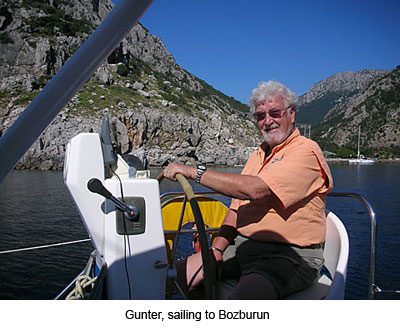
Typical of the history of many of these islands, Symi was occupied by the Turks in 1523, and after the Balkan War in 1912, was turned over to Italy. It was returned to Greece in 1947. From our view, the island appeared rugged and desolate, until we noticed some settlements at its northern tip. We concluded that the majority of the population must be on the western side of its high mountains. According to Homer’s writings, the island possessed eight harbors! It gives one goose bumps to be sailing the seas the ancients plied thousands of years ago!
We sailed part of the way with only the jib, again hard on the wind, as it rose to Force 5, a rather lumpy passage over steep whitecaps. In only three hours time, we were happy to pull into a perfect spot alongside a dock, directly facing the small town of Bozburun.
__________________________________________
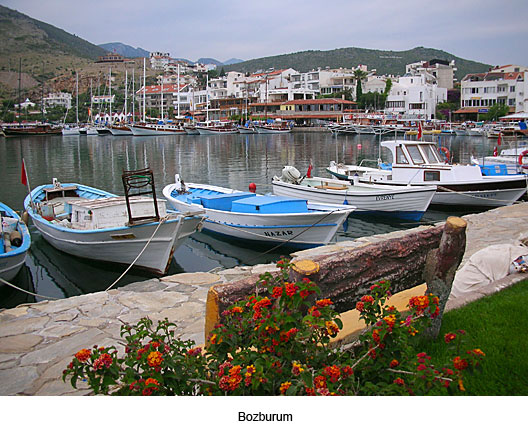 What a cute little town! Bozburun is attempting to become a “mini-Marmaris,” but I hope that it doesn’t lose its laid-back charm in the process. The harbor area fronts a main street lined with gulets and the occasional med-moored yacht. We are fortunate to have one of only 3 side-ties available, at the northern end of the village.
What a cute little town! Bozburun is attempting to become a “mini-Marmaris,” but I hope that it doesn’t lose its laid-back charm in the process. The harbor area fronts a main street lined with gulets and the occasional med-moored yacht. We are fortunate to have one of only 3 side-ties available, at the northern end of the village.
We head to the Akvaryum (pronounced Aquarium) Yacht Club & Restaurant for lunch, which then entitles us to use their shower facilities. I order an omelet with a side of bacon (rare in Turkey). It appears with French fries as well.
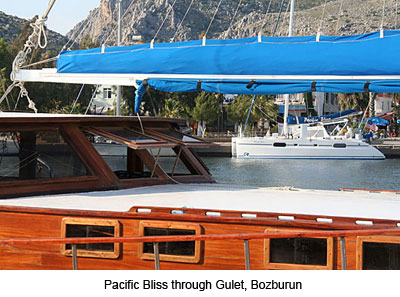 We enjoy walking the town, delighting in the many photo opportunities, and purchasing newspapers, postcards, and fresh fruit. After the lazy afternoon, we have sundowners on Pacific Bliss, and then walk to Osmans for dinner, an important stop in our Culinary Cruise itinerary, recommended by another sailor we met along the way. I order octopus casserole—which arrives bubbling and tastes sumptuous and supple. Oscar, the nephew of another Oscar who runs a restaurant in Selmiye, sits at our table and talks with us. He gives us raki “on the house” so we feel compelled to try it. Gunter takes one taste and dilutes it with water, which turns it milky, like ouzo. Ugly stuff, with a licorice flavor. Fortunately, as Oscar leaves, Gunter dumps the remainder of his glass into a convenient potted plant behind our seats and we all follow suit. I hope the plant survives.
We enjoy walking the town, delighting in the many photo opportunities, and purchasing newspapers, postcards, and fresh fruit. After the lazy afternoon, we have sundowners on Pacific Bliss, and then walk to Osmans for dinner, an important stop in our Culinary Cruise itinerary, recommended by another sailor we met along the way. I order octopus casserole—which arrives bubbling and tastes sumptuous and supple. Oscar, the nephew of another Oscar who runs a restaurant in Selmiye, sits at our table and talks with us. He gives us raki “on the house” so we feel compelled to try it. Gunter takes one taste and dilutes it with water, which turns it milky, like ouzo. Ugly stuff, with a licorice flavor. Fortunately, as Oscar leaves, Gunter dumps the remainder of his glass into a convenient potted plant behind our seats and we all follow suit. I hope the plant survives.
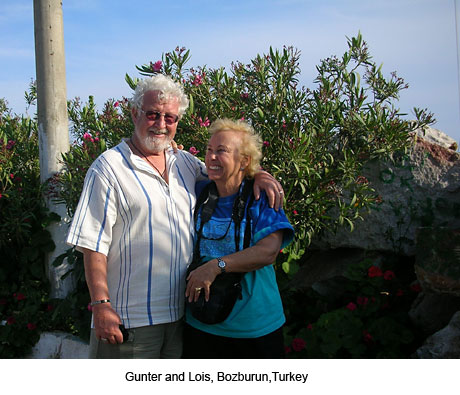
May 11, 2008
Datca, Turkey
36º43.2, 27º41.3
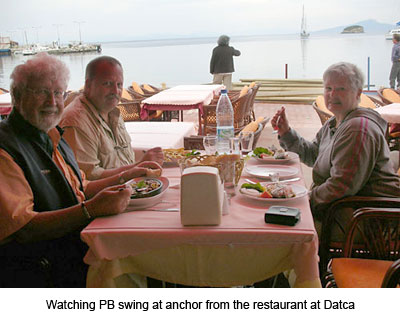 They were just putting the docks back out at the town harbor here in Datca (pronounced Datcha) so we anchored in the bay off the town. This town sleeps even during the day, we noticed upon arriving in our dinghy, Petit Bliss.
They were just putting the docks back out at the town harbor here in Datca (pronounced Datcha) so we anchored in the bay off the town. This town sleeps even during the day, we noticed upon arriving in our dinghy, Petit Bliss.
“Does it get any busier during the high season?” we ask the dark, nice-looking young man in the travel agent’s office. Ret sits in his swivel chair at the lone computer, checking her emails.
“If you mean bustling, yes, it livens up a bit more. I can see the activity from my second-story view up here. But if you mean crazy like Marmaris, no, it never gets like that.”
I can’t imagine that many tourists want to brave two bloodcurdling hours on the narrow road that winds along the mountainous spine of the long Datca Peninsula. But we do see one dolmus (bus) as we amble through the town. It is parked at the main intersection of Datca—a four-way stop without a light.
___________________________________________
We motored here for four hours, most of the time on a glassy sea. “When do we arrive?” asked Ret. She reminded me of when we were kids, all piled into the car for our Sunday afternoon drive.
“It is customary,” replied Gunter, “to arrive at lunchtime on this Culinary Cruise.”
After another customary feta cheese salad with Turkish bread and ½ a dark EFES, I was ready for our customary afternoon nap. What a tough life! In fact, we have become so mellow that we even forgot what day it was, although I knew the date from entering it into the logbook. We had put on our customary Sunday morning music one day early! The International Herald Tribune we picked up said “Saturday” but even that didn’t tip us off, since it is customary in these small towns to get the paper one day late.
______________________________________________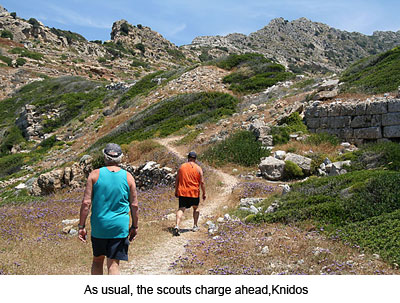
It takes all of 30 minutes to walk the town from one end to the other, including stops at each restaurant billboard to examine the menus. The Culinary Tour brochure touts the Culinarium as a place to go to experience something out of the ordinary. But we opt for the customary, settling on a little restaurant on the boardwalk with a view of Pacific Bliss swinging at anchor. The owner is a heavyset, swarthy man with the most colossal mass of unruly hair I’ve seen since the islands of the South Pacific! When John takes his time to peruse the bill before paying, he looks perplexed. “Are the prices O.K?” Actually, for a fish special, they are cheap—half the price of the Loryma for a similar meal, where they had to boat in supplies. John looks up at the distressed proprietor.
“O.K.” How nice to encounter a proprietor who actually cares how the tourists will react.
We dinghy back to Pacific Bliss as the slanting rays bathe the shops and restaurants of Datca in a golden glow. Over a bottle of Chilean red from the bilge, Ret and John pore over the Imray Turkish Waters Pilot to select ports and anchorages. It is time to get serious. At some point, we need to wrap up this Casual Culinary Cruising and get crackin.’ By the end of the evening, we have outlined a tentative day-by-day plan to determine when we’ll be in Ephesus for our tour. And we have selected our final destination, Cesme, for our crew to catch their flight from Izmir to Istanbul.
May 12, 2008
Knidos, Turkey
36º41.1’N, 27º22.45’E
It is another day of motoring, the engine droning along at 6 knots in a monotonous rhythm. But after a half-day, we are side-tied to the only restaurant dock in Knidos, at the tip of the Datca Peninsula. As we tie to the cleats and add a few more fenders, just in case, I am humbled by the good fortune we have of living in an archeological museum. We have a perfect view of an old Roman amphitheater dug into the sides of the mountain, its shell-shape facing the harbor, preserved in quite good condition. On the other side of the harbor, ancient terraces are still planted with groves of olive and almond trees. How blessed we are to be able to view these ancient wonders from our own sailing vessel!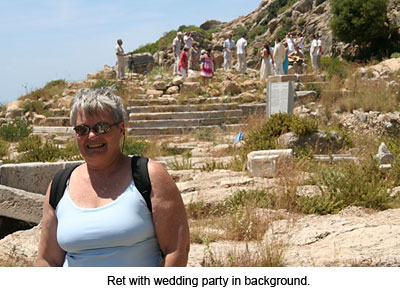
We lunch on a shrimp salad Ret and I prepared along the way, but there are no leisurely naps on this day. We are eager to explore, even in the mid-day sun.
As we climb up a path to the hills, the view keeps getting better and better. First we see the restaurant roof and yachts along the wooden dock, then the sea behind, and finally the view of two harbors, one on each side of the Knidos peninsula. Silted in, the tip had once been a separate island called Cape Krio.
Knidos was once a prosperous port city dating from 400 B.C. The conniving Dorians who founded it knew that the winds change as soon as one rounds the pointed peninsula. Ships would wait at Knidos to get good winds, giving the port a prosperous business in ship repairs, hospitality, and trading. The ship carrying the Apostle Paul to Rome for trial was one of the many that had to hole up here for awhile.
The ruins of the ancient city are scattered all along a three-kilometer stretch now shared with goatherds and their flocks, and the occasional wild boar. Only partly excavated, they are a hodge podge of huge rock blocks and pottery shards. There is even a drop-off behind the restaurant for one to leave anything of value. I feel like a true adventurer. It seems romantic to uncover these stones with Greek inscriptions and drawings all by ourselves, without a guide and hordes of tourists. 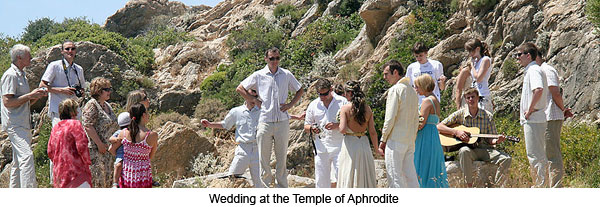
A gulet anchored in the harbor brings a Turkish wedding party with their guests. They soon catch up to our vantage point, the ruins of the Temple of Aphrodite, the goddess of love. We perch on a rocky outpost away from them, but yet close enough to observe the ceremony. The bride is radiant in a filmy natural-colored Grecian dress with a bare back. It has golden, braided straps and waist detail. Matching golden clasps adorn her shoulder-length, dark brown hair. The bridesmaid wears a teal sundress and all the men, white gauze shirts. After the service, a man opens a large guitar case he had lugged all the way up the hillside and begins to play
.
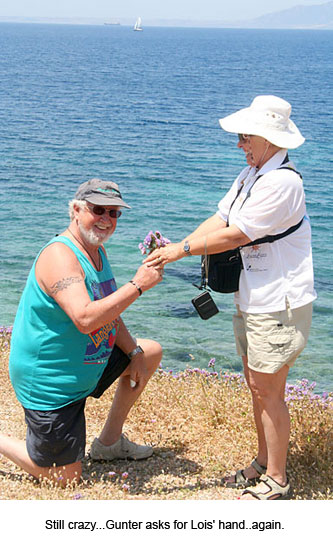 From the heights, it is easy to pick out the skeleton of the ancient city and to identify its parts. The city had not only one, but two, theaters, a second one farther up the slope. It had at least four temples, the agora, city walls and gates, and two harbors. The city had many claims to fame: the statue of Aphrodite here was one of the first in 4th century B.C. of a naked woman; before then the statues had been of men. The sexy Aphrodite was believed to bring good fortune to seafarers. The legends about her abound; one recounts a back door to the shrine so that admirers could view her shapely posterior!
From the heights, it is easy to pick out the skeleton of the ancient city and to identify its parts. The city had not only one, but two, theaters, a second one farther up the slope. It had at least four temples, the agora, city walls and gates, and two harbors. The city had many claims to fame: the statue of Aphrodite here was one of the first in 4th century B.C. of a naked woman; before then the statues had been of men. The sexy Aphrodite was believed to bring good fortune to seafarers. The legends about her abound; one recounts a back door to the shrine so that admirers could view her shapely posterior!
The scientist Eudoxos of Knidos was an astronomer and mathematician considered one of the founding fathers of Greek astronomy. He built an observatory at Knidos. Sostratus, who designed the Pharos lighthouse, one of the seven wonders of the ancient world, was also a native of Knidos.
We wend our way back down past columns of old temples strewn about in the high grass and weeds, some with inscriptions. Four of them have been righted, two with a crossbeam. As we overlook the two ancient harbors, Gunter, still crazy after all these years, picks a few wildflowers and bends on one knee, “Will you still stay married to me forever and ever?” he asks.
“Of course,” I laugh. We sit there awhile, overlooking the bucolic scene. Then we return to the comfort of the cool hull on Pacific Bliss.
We finally succumb to a pensioner’s nap, and afterwards ease into a happy hour, sipping the cabernet sauvignon that is also simmering in the sauce for spaghetti bolognaise. We opt to cook on board, not obligated to eat at a restaurant in return for dockage; there had been an entrance fee of 5 liras each for the 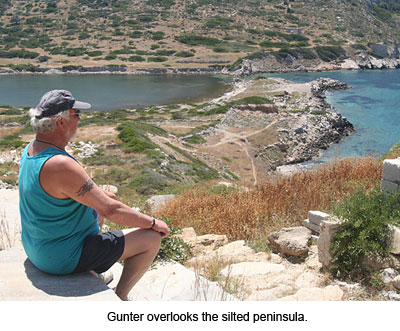 “museum.”
“museum.”
After dinner, Gunter and I take a sunset walk to the harbor-side amphitheatre. We finger the inscriptions engraved into the ancient cement seats. Could they denote reserved seating for wealthy patrons of the arts? We walk up the aisle steps dividing three sections of the theater, much like our modern sports arenas. Then we sit and face the stage, trying to imagine what performances were given here. Homer had traveled this area. Perhaps he gave a reading! As the golden globe falls into the sea below the old temple columns, we walk for awhile along the one-lane, lightly blacktopped road that leads back to Datca, 37 kilometers away. I would not have wanted to take that road and cannot imagine where one would pull off to accommodate a passing vehicle. Again, I am thankful to be traveling by boat.
Later, a half-moon shines over the quiet harbor. The Russian charterers in the two rafted catamarans in front of Pacific Bliss—of a strange design reminiscent of Beluga whales—have finished their vodkas and apparently retired for the night. It is a peaceful night, with no muezzin here to interrupt our sleep.
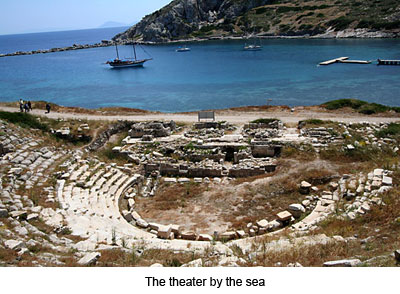
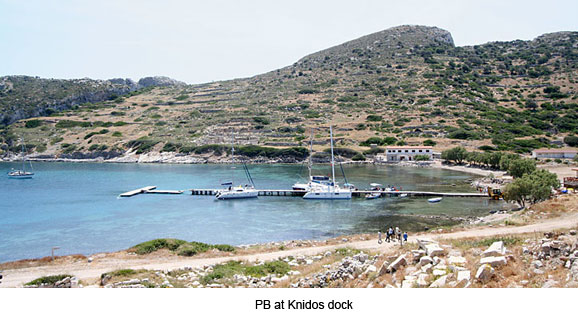
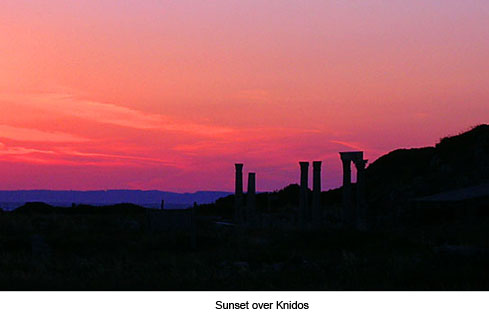
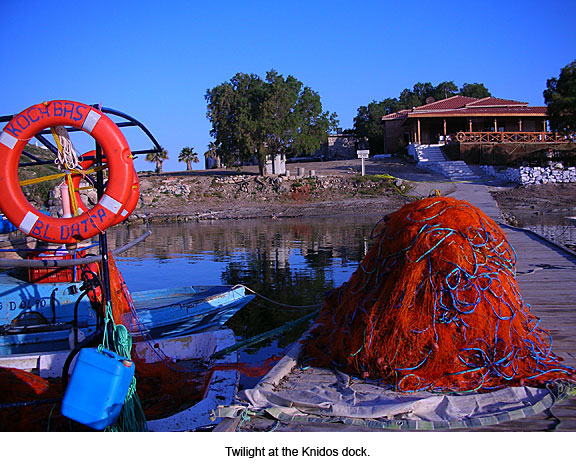
May 13, 2008
Bodrum Marina
37º02’N, 27º25.4’E
Underway from Knidos by 0900, we motor in a Force 3 wind on the nose from the WNW. The sea is lumpy as the wind increases gradually to Force 5, 20 knots apparent. We unfurl the jib for an hour or so, motor sailing hard on the wind, but then the wind veers 100% on the nose, and we bump along uncomfortably over steep, short waves as we cross the bay to Bodrum.
As we pass the long Greek island of Kos, we gain some protection. I’m reminded of another legend: The great sculptor Praxiteles made two statues of Aphrodite, one naked and one clothed, and offered them to the people of Kos, who selected the more seemly clothed version. The daring people of Knidos then decided to buy the naked statue to adorn their circular temple facing the sea. As the word spread about the two statues, Praxiteles made a quite a name for himself. King Nicomedia of Bithynia wanted it so badly that he agreed to pay off the Knidians’ debts for it. But the wily Knidians preferred to hold onto their famous statue. It was last heard of during Christian times, seen in the palace of Lauros in Istanbul. Since then, although the original has vanished, copies exist in Munich, Rome, and New York museums.
Kos is the largest island in the Dodecanese after Rhodes, (which we visited during a ferried day trip from Marmaris). The island’s claim to fame is that it was the oldest cult site of the healing god Askliepos and later for the medical school of Hippocrates (5th century B.C.).
Leaving the shelter of Kos, the wind increases to Force 6, but since it swings to the WSW we can sail it with only the jib. Until that is, it changes back again to the WNW on the nose. We are finding these Mediterranean winds to be quite fickle!
We arrive at Bodrum Milta Marina at 1300, tidy up, check in and then walk along the quay. The harborside walk outside of the marina proper is lined with upscale European shops and restaurants, living up to the town’s name as “the St. Tropez of Turkey.”
After a morning of tough sailing, we are looking forward to a substantial meal. We pass by the Yacht Club and a restaurant called LaJolla, to eat a Turkish meal in the Limani (Harbor) Restaurant. We all order the Liman Meatball Special. It arrives bubbling, in a ceramic casserole dish. The bottom layer consists of pita bread cut into squares, topped by flattened meatballs in a yogurt sauce. The top layer consists of tomato sauce and melted cheese. Perhaps it is because we have really worked up an appetite, but we all vote this meal as one of the best on our Culinary Cruise.
The day goes by with the usual ‘coming into port’ chores, such as hooking up with internet, dropping off laundry, and after a brotzeit with wine, we all retire early.
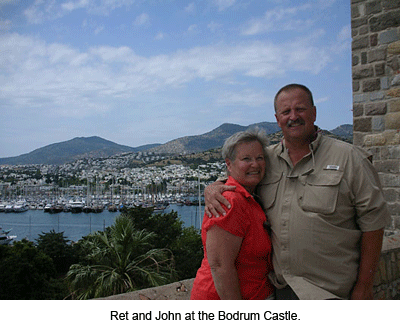
May 14, 2008
Bodrum Marina
The morning is taken up with more boat chores: cleaning Pacific Bliss inside and out, changing all the filters, etc. By 1300, Pacific Bliss is shining white and we are ready to sightsee. On the way to St. Peter’s castle, we stop for individual Turkish pizzas. Excellent!
The castle is the first thing one sees when sailing into Bodrum. It stands like a sentinel on one’s starboard, overlooking two bays, Salmakis Bay and Kambalice Bay. The city curves around the two horseshoe-shaped bays as the houses—square and white like sugar cubes—climb the terraced mountains behind. The castle and the Museum of Underwater Archeology are one in the same, a neat idea.
The Knights Hospitaller, based in Rhodes, conquered Bodrum in the 1400s, and built the mammoth castle to defend it (not always successfully) until the end of WWI. It was used as a storage place for the booty collected during underwater archeology missions and later turned into a museum.
As we walk through the Glass Exhibit, I am amazed to find most of the delicate pieces still intact. The film showing the process of underwater archeology is fascinating, as are the exhibits showing how the diving and retrieval is conducted.
We climb the steep steps to the French Tower, the English Tower, and the German tower, all with their relevant Coat of Arms. Each tower provides a different view overlooking the city and the bay.
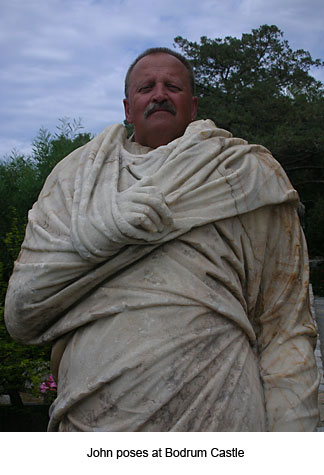 On the way back to Bliss, we shop for souvenirs and provision for the next leg of our voyage along the coast. I am elated to find a Carrefour Express, but then deflated to find that it contains just the usual Turkish products. There will be no pate on our Culinary Cruise.
On the way back to Bliss, we shop for souvenirs and provision for the next leg of our voyage along the coast. I am elated to find a Carrefour Express, but then deflated to find that it contains just the usual Turkish products. There will be no pate on our Culinary Cruise.
We do find a café serving apple pie ala mode. That turns out to be a treat after the sweeter Turkish desserts. Amid the hustle and bustle of tourists from every country along the cobblestoned pedestrian bazaar, I try to imagine what the city was like during ancient days.
Bodrum, called Halicarnassus, was once a great and powerful city, part of the Dorian confederacy. One of its kings was succeeded by his beautiful daughter Artemisia, who was so successful that she was made Admiral of the fleet that formed as part of the Xerxes invasion against Athens. Later on Artemis II ruled as well, and it was during her reign that the massive tomb of Mausolos was built. It became one of the seven wonders of the ancient world and brought the term “mausoleum” to the English language. Destroyed by an earthquake in the 15th century, the tomb was 50 meters high and 120 meters long, the entire edifice adorned with magnificent friezes. The ancient city of Halicarnassus was destroyed by Alexander the Great. Little remains, but we can see parts of the city wall, the site of the tomb, and a theater—looking out across the marina to the terraced mountainside.
Herodotus (482-24 B.C.) the father of written history, was a native of this city, traveling from here to eastern Europe, Egypt, and Asia to gather his material on the nine-book history of the wars between Greece and Persia. He was curious about what made people tick. Remarkably, he depicted the various personalities involved without political partisanship toward his own race.
The brochure about the Culinary Tour ends here at Bodrum. From here on, we’ll have to rely on our Pilot and the Lonely Planet. Looking ahead, the latter part of Leg 1, Voyage Seven will be even more of a journey through ancient history.





